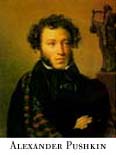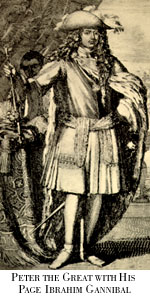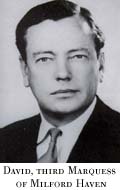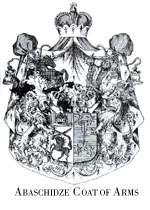


Although the vast majority of African Americans are unfamiliar with Pushkin's
monumental works, most students of literature are at least aware of his
"Blackamoor of Peter the Great," an unfinished romance which relates the
biographical data of the poet's great-grandfather, Ibrahim Petrovitch Gannibal
his black great-grandfather.
Some early critics wrongly suspected that Pushkin attempted to aggrandize the
African lineage of this black forebear by playing up the family tradition that
he was an Ethiopian princeling. However, Pushkin certainly did not need to
embellish his ancestor's own personal history. For the accomplishments of
Ibrahim Petrovitch Gannibal are proof of what any man - despite his colour -
could rise to, given the opportunity. Ibrahim was treated as no less than a
member of the royal family at court and, in the biographical notes on him
written either by his wife or by someone in her family shortly after his death,
the following statement is made:
"....he (Peter) wished to make examples of them and put (Russians) to shame
by convincing them that out of every people and even from among wild men - such
as Negores, whom our civilized nations assign exclusively to the class of
slave, there can be formed men who by dint of application can obtain knowledge
and learning and thus become helpful to their monarch."
 To a divine rights monarch like Peter whose relationship to a nation of serfs
was entirely paternalistic, a child as a personal gift or possession could only
be regarded as one of his own kith and kin. Indeed, at the eight-year old
Ibrahim's baptism, the Emperor himself was his godfather, while his godmother
was the Queen of Poland.
To a divine rights monarch like Peter whose relationship to a nation of serfs
was entirely paternalistic, a child as a personal gift or possession could only
be regarded as one of his own kith and kin. Indeed, at the eight-year old
Ibrahim's baptism, the Emperor himself was his godfather, while his godmother
was the Queen of Poland.
Although, as we now realize, no Blackamoor at any 18th century European court
was merely decorative, in Ibrahim's case, Peter's expectations for him were as
loaded with responsibility as those he would have had for his own son. If he
was the Emperor whose patriotic duty it was to drag Russia spiritually and
intellectually out of its Byzantine backwardness and into the future of the
Enlightenment, then it would literally be Ibrahim's responsibility to care for
his adopted country's physical formation and his defence of it. In 1717 the
young blackamoor was sent to France for an education in both civil and military
engineering. He studied at the Ecole d'Artillerie of La Fere under the
brilliant Bernard Forest de Belidor and afterwards, at the Ecole d'Artillerie
of Metz, an institution founded by the illustrious Sebastien Le Preste, Marquis
de Vauban.
Besides the education which prepared him for his long life of government
service, Ibrahim returned from France with something he obviously regarded just
as importantly - a name. Like any black kid today reaching back through time
to clutch at whatever historical straw of affirmation he can reach for, Ibrahim
not only identified as his model but appropriated as his surname that of the
Carthaginian general, Hannibal. Although it could be argued that like
Hannibal, he knew that he too would soon enough attain the rank of general,
Ibrahim's choice probably betrayed an almost adolescent edge of race conscious
defiance considering the threat this Punic potentate had once posed to Rome.
Perhaps a better understanding of what Ibrahim intended to imply with his new
name can be gathered from what we know today regarding one of the stock theatre
characters of his time. Sofonbisba, a relative of the historical Hannibal, was
easily the most popular of the 18th century heroines. During that period alone
more than forty works, either operas or dramas, were composed with hers as the
central story. It would appear that the proud African queen who fought Roman
occupation to the point of committing suicide had become the personification of
independence for a number of European states that were growing increasingly
irritated with Hapsburg hegemony.
- More from Mario de Valdes y Cocom
- What Might Have Been...
Valdes continues to trace Pushkin's black ancestry as it moved through Europe's royal families in this article from Majesty Magazine. (December 2008)
Considering that the defining line in a family's history was its patrilineal
descent as it was just about anywhere else in the western world, Pushkin's
preoccupation with his African ancestry is all the more telling since Ibrahim
Gannibal was his maternal great-grandfather. Furthermore, Nadja, his mother,
was through her own mother, a descendant of the same Pushkin forbear from whom
her husband Serge descended. This is genetically interesting since it explains
why the poet, who is generally but mistakenly accepted as an octoroon, looks
perceptibly blacker.
A contemporary chapter on Pushkin's lineage: The Mountbattens
Although most of the above history is related in discussions about Pushkin's
African ancestry, no works - at least those translated or written in English -
have ever commented on the descendent of the great poet. And this, despite the
fact that Joel Rogers in "Sex and Race" (a privately-published work which has
turned into a cult classic) traced the line of one of Pushkin's daughters into
the Mountbatten branch of the British Royal family.
(Perhaps the fact that Pushkin's daughter Natalie married a prince was too much
for either the Bolsheviks or the West's liberal intellectuals who saw in the
proletariat sentiments which had on occasion been expressed by the national
poet, a spiritual source of the Revolution. Even if it was a well-known fact
that Pushkin sold the serfs he had inherited so that he could afford the
pampered wife he wished to wed, standard Soviet doctrine was that he had been
the first to dip his pen in red ink.)
Because she herself was not royal, Natalie Pushkin's wedding to Prince Nicholas
of Nassau in 1868 was officially designated a morganatic marriage. The term
'morganatic' is a hold-over from a stricter hierarchical time. This term of
precedence became more familiar as an increasing number of European royalty
towards the end of the last century were slowly forced to adjust to the social
changes that had begun to affect the rest of the world. The morganatic title
created for Natalie was Countess of Merenberg with the right to bear the title
of Count or Countess of Merenberg by her children. A good indication of just
how strict the old order had been can be seen from the fact that even though
her husband was a prince of the House of Nassau, when it came time for her
daughter in turn to wed, her marriage to a member of the Imperial Russian
family was also declared a morganatic one. Although the wife of Grand Duke
Mikhail, Sophia and the children she bore him were officially known as the
Counts and the Countesses de Torby. (No matter how tempting to attribute it as
an example of racism in high places, the fact that he was the offspring of a
morganatic relationship was probably what prevented Sophia's brother, George,
from succeeding his uncle William as Grand Duke of Luxemburg. Faced with a
choice between George, Count of Merenberg and the abrogation of the Sallic Law,
which excluded females from the succession, the Luxemburg parliament chose the
latter allowing Charlotte to claim the throne as Grand Duchess of Luxemburg.)
Interestingly enough, Sophia's daughter, Nadjeda, on the other hand, married
someone of exactly her own social standing. George Battenberg was the grandson
of Queen Victoria (the name would not be changed to Mountbatten until the
outbreak of World War II). However, he too was descended from a royal
morganatic line. Battenberg was the principality bestowed on the Countess
Julie Hauke and her children after her husband, the Prince of Hesse, had been
reconciled with his father for having eloped with her.
On the day of Nadja's wedding in the Chapel Royal at Buckingham Palace the
majority of the stories covering the event hysterically pointed to Nadjedja's
African ancestry and snidely speculated about the probability of this branch of
the Royal Family producing black babies. It should be pointed out, however,
that the Times maintained both its integrity and its dignity. As was to be
expected from a journal of such literary standards,the fact that the bride was
a descendant of the great Russian poet was duely mentioned but what
editorializing they did was instead centered on the morganatic backgrounds of
both spouses.
With so many published memories and histories of the Mountbattens available
today, it is disconcerting to find so few references to Nadja. As the
Marchioness of Milford Haven, she was not only Prince Phillip's aunt, she also
was actually his stepmother during a period of his adolescence.. When his
parents, the Prince and the Princess Andrew of Greece, were exiled at the
beginning of the war, Prince Phillip was sent to the Mountbattens of Milford
Haven since the Marquis was his mother's elder brother. (Incidentally, his
mother's title, 'The Princess Andrew of Greece,' is an indication that hers too
was a morganatic marriage like the others referred to above.)
Intriguingly, the little published information on Nadjeda available can be
found in a biography of Gloria Vanderbilt. Because of the kind of work it is,
I cannot help but suspect that the few glimpses we get of Nadjeda are highly
coloured. Not only is the reader given a detailed description of the negroid
quality of her hair, (a highly implausible observation considering how many
generations distant Nadjeda was from her Abysinian ancestor), but, to make for
obviously even racier reading, she is portrayed as bisexual. Whether or not,
as the author would have us believe, she along with her husband were earlier
examples of the racous royals that 'Fergie' and 'Di' became will have to be
verified for she also alludes to the extensive and priceless collection of
erotica for which the Marquis and Marchioness of Milford Haven were supposedly
famous. Until I have a chance to check sources for myself, I might have to
accept that this, and not what I would be inclined to think, could be the
reason why so little is related about her in the biographical works on Prince
Phillip or other members of the Mountbatten clan.
Since both her husband and his brother, Louis, who would in time be made
Viceroy of India, were Navy men during the earlier years of their marriage,
Nadja and her sister in law grew quite close and in fact made news together
when they piloted a two seater De Haviland on a jaunt of Eastern Europe, the
Middle East and North Africa. Even though the press does not appear to have
commented on the combination at the time, it should be pointed out that Alice
represented another racial addition to the Mountbatten bloodline since she was
the granddaughter of Lord Temple, a scion of the banking house of Ashley which
like the Hambros had converted from Judaism in the late l8th century. If
there is any truth to the speculation about her relationship with Nehru, then
there is a third racial element which, even with an association such as this,
expands the ethnic ethos of the Mountbattens into something of almost global
proportions.
Taking this particular perspective on his background into consideration, we are
provided with at least an inkling of what Prince Phillip's liberalism is
perhaps based on. Given both the anti-black and the anti-semetic sentiments so
pervasive during his formative years, he could not have been unaware of
whatever pain or social embarrassments his family might have had to endure
because of these two aunts' genealogies. Much has been made of how both the
Queen's and his mother's families had to change their names (the House of
Hanover to that of Windsor and that of Battenberg to Mountbatten) to cope with
the anti-German propaganda of the First World War. But no one has offered any
insights as to how the Royal Family might have dealt with two ethnic strains
which, if they had not been who they were, would certainly have caused them to
be ostracized from those circles that wielded political power.
 If we play along with the protocols by which this echelon of society is
governed, Prince Phillip's choice of best man at his wedding to the Queen,
could be explained by the fact that as head of the house of Mountbatten, David,
3rd Marquis of Milford Haven, was his only option. Since the 2nd Marquis was
already deceased, David, according to the rules of this game, had to be
recognized head of the entire Mountbatten family, even if his uncle Louis had
precedence over him at court due to the powerful position he occupied as
Viceroy of India. Phillip's choice, however, was probably based on the simple
reason that since he and David were, for at least a part of their adolescent
years raised together, David was as much of a brother Phillip ever knew.
Nevertheless, because of all the throat clearing the press had done at his aunt
and uncle's wedding, and because of the scrutiny the members of his own wedding
to the future Queen of England would be subjected to, I cannot help but suspect
that Prince Phillip's decision was also a socio-political one. The very idea of
the Mountbattens leaving themselves that wide open as targets to whatever
racial slurs were possible during the early fifties, had to have been carefully
calculated.
If we play along with the protocols by which this echelon of society is
governed, Prince Phillip's choice of best man at his wedding to the Queen,
could be explained by the fact that as head of the house of Mountbatten, David,
3rd Marquis of Milford Haven, was his only option. Since the 2nd Marquis was
already deceased, David, according to the rules of this game, had to be
recognized head of the entire Mountbatten family, even if his uncle Louis had
precedence over him at court due to the powerful position he occupied as
Viceroy of India. Phillip's choice, however, was probably based on the simple
reason that since he and David were, for at least a part of their adolescent
years raised together, David was as much of a brother Phillip ever knew.
Nevertheless, because of all the throat clearing the press had done at his aunt
and uncle's wedding, and because of the scrutiny the members of his own wedding
to the future Queen of England would be subjected to, I cannot help but suspect
that Prince Phillip's decision was also a socio-political one. The very idea of
the Mountbattens leaving themselves that wide open as targets to whatever
racial slurs were possible during the early fifties, had to have been carefully
calculated.
Considering the fact that Pushkin was well aware of the kind of impact his
literary success could have on the institution of slavery in the new world, I
think we can be fairly certain that, for the same racial reasoning, he would
have been quite pleased to know that a branch of the British Royal Family would
today be numbered among his descendants. As a 19th century man he probably
regarded any European royal family member as some sort of genetic distillate
of political world power that could trace its origins, even in a few rare
instances, to the Roman Empire.
Finally, Pushkin would have found it humorously ironic that if only he had
stressed his royal Ethiopian ancestry, he might have removed the stigma of
'morganatic' from the marriages of his daughter and his granddaughter. For
after all, his great-grandfather was an Ethiopian prince. Furthermore, since
the Ethiopian Royal House belonged to the dynasty founded by Menelik, the son
of the Old Testament King Solomon and the Queen of Sheba, this wedding from a
religious perspective could have been seen as a particularly propitious one for
it introduced the blood line of the Messiah into the tightly intermarried royal
gene pool of Europe.
 Interestingly enough, the Gannibal was not the first black noble family of
Russia. Because the name itself, "abach" means Abysissinian, the princely
house of the Abachidze has long been known to be Ethiopian in origin.
With the rise of Paata to political prominence in the early 17th century, they
intermarried with and became lineal ancestors of the royal houses of Imerithia
and Georgia of the Caucuses.
Interestingly enough, the Gannibal was not the first black noble family of
Russia. Because the name itself, "abach" means Abysissinian, the princely
house of the Abachidze has long been known to be Ethiopian in origin.
With the rise of Paata to political prominence in the early 17th century, they
intermarried with and became lineal ancestors of the royal houses of Imerithia
and Georgia of the Caucuses.
The Arapov also claim that they derived their name from the word, "arap"
or arab, the Russian for Negro. Beginning in 1613, they have filled military
posts as generals and such court positions as a governor and a member of the
Ministry of Agriculture.
Another family that tradition and legend have traced back to Africa is that of
the Axakov. They apparently came to Moscow in the entourage of Prince
Danila Alexandrovitch of Souzdal,1251-1303.
An even earlier black immigrant was Chimon Afrkanovich who arrived in Russia at
the beginning of the XI century and entered the service of the Grand Duke
Iaroslav Vladimirovich of Kiev. A number of his descendants who carried the
name, Isleniev, held high ranking positions in the army. Petr
Alexeevitch, for example, was aide de camp to Catherine the Great.
|